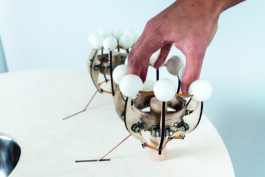










Senseware – From Feeling to Feedback
In the project Senseware we dealt with the sensuality of objects, products and functions. The term Senseware was coined by Japanese designer Kenya Hara and describes objects and artefacts with a strong sensual quality. Building on this, we actively explored the tactile and haptic qualities inherent in certain materials and forms and how they can be combined.
In this project, we attached great importance to intensive prototyping and worked with different programs that can be used quickly and according to the design phases.
Since products are no longer just static, but increasingly dynamic, the students learned to develop their own functioning prototypes with Arduino and electronic controls and implement them as 1:1 models.
We started the semester with a field trip to Berlin where we visited several design studios and the Museum of Natural History.
The first stop was Studio 7.5 where we experienced the importance of prototypes and the magic of custom tools.
After leaving 7.5’s cosy workshop we visited Archimedes. At Archimedes architects, media designers, carpenters, product designers, electronics specialists and other professionals work together under a big roof in different workshops and office spaces to create exhibition designs and experience spaces.
We completed the first day with a visit at Christian’s own studio The Constitute in Kreuzberg where we had pizza and got to know each other.
The second day started with a visit to Berlin’s Museum of Natural History where we were allowed to see the collections of minerals, insects, birds and other species that are usually not open to the public.
Our last stop was at Pfadfinderei, a design and motion-graphics studio specalizing in creative services for stage entertainment, media installations, trade shows and events.
The second field trip took us to Berlin again. This time we visited the Retune Digital Arts Lab @hub.berlin. The students could meet and talk to real live artists and designers who work in the fields of clay printing, internet of things, machine learning, intelligent mushrooms and virtual reality. A rich and exciting experience for everyone!
In a one day Arduino kick-off workshop the students got to know the basics in hardware programming. During the course of the project the students developed their new skills that would become both, tools and inspiration for the students’ final projects.
Since the focus of this projects were tactile and haptic experiences we found it important to concentrate on language first. Being able to describe certain material qualities is a crucial skill of designers. The students collected large amounts of organic and non-organic materials and objects which they then categorized and decribed as accurately as possible.
For future use of our collection of descriptive words we designed a deck of cards that can help describing the different features of a certain material or object.
Students: Max Gruber, Christoph Heidebrecht, Hannah Kannenberg, Simon Krautheim, Yang Ni, Josua Roters, Alexia von Salomon, Luis Schlicht, Chunxiao Shi, Theda Vollert, Johannes Vondey, Linus Winkler





